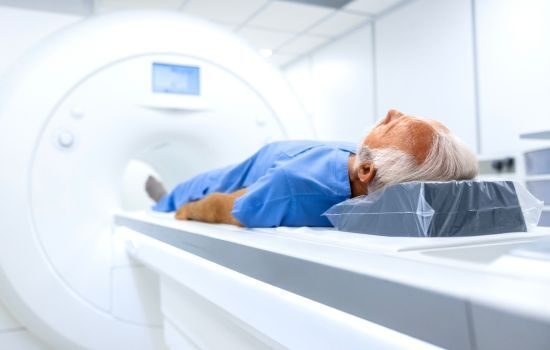Attention GCI Patients — Effective October 6, 2025, the GCI Oak Lawn location will be closed. All patients of GCI Oak Lawn will be seen at our Chicago Ridge location at 10604 Southwest Highway, Suite 109, Chicago Ridge, IL 60415.
September 6, 2024
How MRIs Are Used When Diagnosing Prostate Cancer

Part of prostate cancer screening is a PSA test each year. If your urologist feels the results are running higher than average for your age over the course of a few tests, it might be time to run some imaging tests to see if there is anything unusual in the prostate. In some cases, a non-cancerous condition can be detected on the MRI as the cause of an elevated PSA. For others, prostate cancer is suspected after reviewing the MRI images, and a biopsy will be performed to finalize a prostate cancer diagnosis.
An MRI is the go-to imaging option because it captures the most accurate prostate images. Once a radiologist reviews the MRI results, they will include a PI-RADS score on the report. This particular scoring system provides valuable information about whether a biopsy is necessary.
Understanding the PI-RADS Scoring System
The Prostate Imaging Reporting and Data System (PI-RADS) is a standardized scoring system for possible prostate cancer cases. It has improved the prostate cancer diagnosis process by reducing the need for biopsies before they’re necessary.
To determine the PI-RADS score, patients must first undergo an MRI. The images obtained from the MRI are then individually scored between one and five. The final score is equal to all of the scored areas added together.
The PI-RADS score is determined by the radiologist who reviews the MRI images. The scores are outlined by the following:
PI-RADS 1: very low risk; no signs of prostate cancer.
PI-RADS 2: low risk; prostate cancer is unlikely.
PI-RADS 3: intermediate risk; clinically significant prostate cancer may or may not be present.
PI-RADS 4: high risk; clinically significant prostate cancer is likely to be present.
PI-RADS 5: very high risk; clinically significant prostate cancer is most likely present.
Significance of PI-RADS in Prostate Cancer Detection
Typically, the journey toward prostate cancer diagnosis starts with detecting a steady rise of PSA in the blood. From there, your urologist will work to rule out common conditions such as prostatitis and benign prostate hyperplasia (BPH). To do that and to avoid going straight to a prostate biopsy, the doctor will request MRI imaging to take a closer look at areas of concern.
Keep in mind that MRI images and the PI-RAD score are not the final prostate cancer diagnosis. Instead, they are used to determine if additional testing should be done. Before relying on MRIs, many men had to undergo a biopsy that resulted in no signs of prostate cancer. A biopsy is typically scheduled if a PI-RADS score is three or higher.
Can an MRI be Used After a Prostate Cancer Diagnosis?
MRIs are also used after prostate cancer is diagnosed. Because it’s usually a slow-growing cancer, an MRI can be repeated periodically to see if there is evidence that the cancer is growing. The results help the urologist or oncologist decide whether to start treatment or perform another biopsy.
MRI technology is also used during the biopsy to guide the physician on where to take samples based on anything abnormal in the imagery.
Prostate Biopsies Guided by MRI Technology
During a biopsy, up to 9-12 different samples are taken from various areas of the prostate. The MRI guides the selection of these samples to identify the areas in the MRI that produced a PI-RADS score. Following the biopsy, the pathologist reports the results, including the Gleason score.
The pathologist examines the two most predominant cell patterns found in the samples. Each one is given a score between 1 and 5. A score of one means the cells look normal, and a score of 5 means the cells are highly abnormal. Adding these two scores together creates the Gleason score. A score of five or under is not considered cancer.
Here is a further breakdown of elevated Gleason scores:
Gleason 6: This is classified as low-grade cancer, and treatment does not usually start right away. Instead, watchful waiting begins, which is when the patient is monitored every six months or more often to determine if the cancer is growing more. Sometimes, a biopsy may be done if the Gleason score rises.
Gleason 7: The score of 7 is unique in that the treatment plan depends on how the numbers are added together to get to seven. The oncologist may recommend watchful waiting if the most predominant pattern scored a three and the secondary cell pattern scored a four (3+4). A score of 4+3, however, indicates that the cancer is growing, and it may be time to start treatment. This is classified as intermediate-grade cancer.
Gleason 8, 9, or 10: These scores mean that the cells look very different from healthy cells, referred to as poorly differentiated or undifferentiated. Treatment is recommended right away. This is considered high-grade prostate cancer.
Don’t Forget To Screen for Prostate Cancer Regularly
It’s important to see your doctor for regular prostate cancer screenings. Starting at 50, you should begin PSA blood tests as part of your regular checkup routine. Make sure to inform your doctor about any changes to your health or new symptoms you may be experiencing. Remember that elevated PSA levels can be a sign of other conditions, and it’s always important to rule out other issues and treat them appropriately.

Leading Prostate Cancer Treatment in the Chicago Area
At Affiliated Oncologists, our dedicated team is here to help you review treatment options and the right timing for treatment if you receive a prostate cancer diagnosis. We will review your results and work with you to create a customized prostate cancer treatment plan that suits your needs. For many patients, surgery is not necessary.
We offer locations in the south Chicago suburbs for consultations with a prostate cancer specialist. We also provide second opinions so you can confidently select the right treatment plan.
Categories: Prostate Cancer